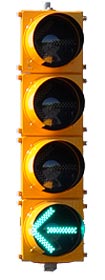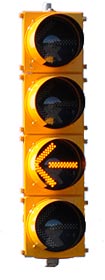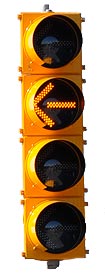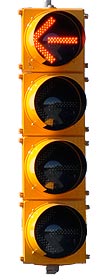Georgia DOT is now installing four-section Flashing Yellow Arrow (FYA) signals across the state. This traffic signal includes a flashing yellow arrow that means drivers can turn left after yielding to oncoming traffic and pedestrians (oncoming traffic still has the green light).
How it Works?
The new signals are easier to understand because it uses an arrow to display the type of left turn movement allowed. Here’s what the various arrows mean:

Solid Green
Ok to turn left; oncoming traffic must stop

Flashing Yellow
Ok to turn left after yielding to oncoming traffic and pedestrians

Solid Yellow
Prepare to stop or clear intersection before solid red arrow appears

Solid Red
STOP - no turn allowed
Criteria
The following criteria is used to help select appropriate locations:
- Intersections where traffic congestion is a recurring problem.
- Most “eligible” intersections have standard “dog house” 5-section traffic signal - drivers make “permissive left.”
- Most “eligible” intersections have high traffic volumes and accident rates.
NOTE: Flashing Yellow Arrows is the preferred left turn treatment for all new signal upgrades. If the traffic signal has a malfunction the left turn will flash red. As with all signalized intersections, a flashing red is treated as a stop condition and flashing yellow is treated as proceed with caution. If all indications at an intersection are flashing red or the intersection is dark it should be treated as a four-way stop.
Benefits
Flashing Yellow Arrows are just one of Georgia DOT’s operational improvements that are cost-effective, proven, innovative and safe. Federal Highway Administration (FHWA) encourages the use of Flashing Yellow Arrows. Based on FHWA guidance, Georgia DOT policy now identifies Flashing Yellow Arrows as the preferred intersection traffic signal.
FHWA studies found that flashing yellow arrows:
- Help reduce left turn crashes by 35%
- Move more traffic through an intersection, easing traffic congestion
- Reduce vehicle idling and air pollution
- Reduced pollution
NOTE: Drivers made fewer mistakes with the new Flashing Yellow Arrows than with traditional left-turn arrow signals.